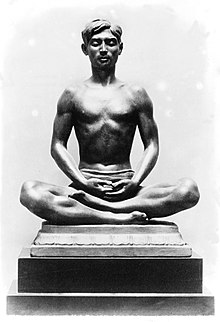
Back Gheranda Samhita BCL ঘেরন্দসংহিতা Bengali/Bangla Gheranda Samhita Catalan Gherandasamhita German Gheranda-samjita Spanish Gheranda samhita French ઘેરંડ સંહિતા Gujarati घेरण्ड संहिता Hindi Gheraṇḍa Saṃhitā Italian घेरंड संहिता Marathi

| Part of a series on |
| Hindu scriptures and texts |
|---|
 |
| Related Hindu texts |
There are no fetters like those of illusion (maya),
no strength like that which comes from discipline (yoga),
there is no friend higher than knowledge (jnana),
and no greater enemy than egoism (ahankara).
—Gheranda Samhita, 1.4
Translator: Srisa Chandra Vasu[2]
Gheranda Samhita (IAST: gheraṇḍasaṁhitā, घेरंडसंहिता, meaning “Gheranda's collection”) is a Sanskrit text of Yoga in Hinduism. It is one of the three classic texts of hatha yoga (the other two being the Hatha Yoga Pradipika and the Shiva Samhita), and one of the most encyclopedic treatises in yoga.[3][4][5] Fourteen manuscripts of the text are known, which were discovered in a region stretching from Bengal to Rajasthan. The first critical edition was published in 1933 by Adyar Library, and the second critical edition was published in 1978 by Digambarji and Ghote.[6] Some of the Sanskrit manuscripts contain ungrammatical and incoherent verses, and some cite older Sanskrit texts.[6]
It is likely a late 17th-century text, probably from northeast India, structured as a teaching manual based on a dialogue between Gheranda and Chanda.[7][8][9] The text is organized into seven chapters and contains 351 shlokas (verses).[8]
- ^ James Mallinson (2004). The Gheranda Samhita: The Original Sanskrit and an English Translation. Yoga Vidya. pp. 70–72. ISBN 978-0-9716466-3-6.
- ^ Rai Bahadur Srisa Chandra Vasu (1996). The Gheranda Samhita. Munshiram Manoharlal. pp. 2–3. ISBN 978-8121507349.
- ^ James Mallinson (2004). The Gheranda Samhita: The Original Sanskrit and an English Translation. Yoga Vidya. pp. ix–x. ISBN 978-0-9716466-3-6.
- ^ B. Heimann (1937), Review: The Ǧheraṇda Saṁhitā. A Treatise on Haṭha Yoga by Śrīś Chandra Vasu, The Journal of the Royal Asiatic Society of Great Britain and Ireland, Cambridge University Press, No. 2 (Apr., 1937), pp. 355-357
- ^ Georg Feuerstein (2011). The Path of Yoga: An Essential Guide to Its Principles and Practices. Shambhala Publications. pp. 13–14. ISBN 978-0-8348-2292-4.
- ^ a b James Mallinson (2004). The Gheranda Samhita: The Original Sanskrit and an English Translation. Yoga Vidya. pp. xiv–xvi. ISBN 978-0-9716466-3-6.
- ^ James Mallinson (2004). The Gheranda Samhita: The Original Sanskrit and an English Translation. Yoga Vidya. pp. x–xiii. ISBN 978-0-9716466-3-6.
- ^ a b Mikel Burley (2000). Haṭha-Yoga: Its Context, Theory, and Practice. Motilal Banarsidass. pp. 8–9. ISBN 978-81-208-1706-7.
- ^ Georg Feuerstein (2011). The Path of Yoga: An Essential Guide to Its Principles and Practices. Shambhala Publications. pp. 55, 59–60. ISBN 978-0-8348-2292-4.